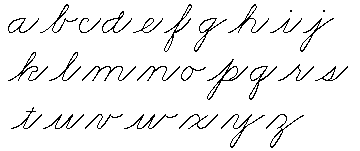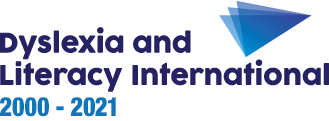For teaching spelling
Teaching cursive writing



For children with dyslexia it is important to encourage writing in cursive style in all contexts. Every time the pen stops or is taken off the paper there is the opportunity for error.
The major advantage of cursive writing is that the pencil or pen is lifted less often, which eases the flow of the writing.
With cursive script, it is also much easier to see where words begin and end.
As there are many possible cursive scripts available, it is important that you teach using the same font, especially to children with dyslexia. The American D’Nelian cursive writing seems particularly suited because easily reversible letters like < b >, < d >, < p >, and < q > are represented in quite different ways in this script.
At any rate, you should use the same font when teaching any cursive writing.
If cursive writing is not familiar to you and you want to see all the letters of the alphabet written in cursive writing, here’s an example:

Prepare lined paper for children with dyslexia and allow them to ’write big’ between four lines: two lines in the middle for small letters like < a >, an upper line for the letters with up-strokes like < b >, and the lower line for down-strokes like < g >. Like this:

Try to encourage children to hold their pen appropriately and to sit comfortably when writing.
If you want to know more about posture, pen grip, and paper position (taken from Teaching Today, staff development, BBC Education):
Teaching regular words




For teaching the spelling of regular words, the multisensory routine SOS (Simultaneous Oral Spelling) is effective. It was developed by Gillingham and Stillman.
There are several variants of SOS, but they contain at least the following steps:
- the teacher says the word
- the pupils repeat the word and then name the letters
- the pupils name the letters at the same time as they write them down in cursive writing
- the pupils check if they have spelt the word correctly
This technique helps establish associations between the auditory, the oral-kinaesthetic (through repetition), and manual-kinaesthetic (naming letters as they write) modalities.
For irregular words in which a ‘sound’ may be written in different ways, you can help by giving the words in ‘families’ in the same way as you did for reading. Let the pupils use different colours to show similar correspondences, for example for the various spellings of the long vowel [ â ]:
acorn, alien, apron, …
rain, train, saint, …
eight, neigh, eighteen, …
say, stay, play,…
then, for the less frequent spellings:
reign, veil, reins, …
grey, obey, prey, …
then, for the exceptions:
steak, great, break
Teaching irregular words




There are several multisensory methods for teaching irregular words where Simultaneous Oral Spelling strategy cannot be used on account of the irregular ‘letter’-‘sound’ correspondences. Different methods suit different children. Here are some examples:
Fernald’s (1943) method of teaching irregular words
- – pupils receive large cards on which the word is written in cursive style (possibly from a ‘pack of irregular words’ for reading)
- – the word is divided into syllables with a pencil
- – the pupils follow the letters with the finger of the writing hand, saying each syllable as they trace it
- – they repeat this action several times until they sense that they can spell the word
- – the card is hidden and the pupils write the word from memory as they say it
- – if the spelling is correct, they repeat the action by tracing the word with their finger
- – the word should then be practised in context
This procedure trains the auditory and manual-kinaesthetic modalities.
Another example, which has many variants, is known as LCWC: Look, Cover, Write, Check.
Example of LCWC routine for spelling irregular words, as described in the Dyslexia Institute Learning Programmefrom Dyslexia Action
- – the teacher shows the word for several seconds, asking the pupils to look carefully
- – the pupils say the word
- – the pupils name the letters in the word (spelling out loud)
- – the pupils copy the word
- – both teacher and pupils hide the word
- – the pupils repeat the word
- – the pupils spell the word
- – the pupils write the word again
- – the teacher shows the word again and the pupils check their own
spelling
The different steps are repeated until the pupils can spell the word.
This routine can be practised as a game by playing an ‘accordion’ on a large sheet as the children copy the word (the fourth step above), bend over the ‘key’ on to the word to hide it, and then write it. If the answer is wrong they bend the ‘key’ back out again and repeat the step. The game is played to make the smallest possible accordion in the time given.
When teaching irregular words, internationally recognized experts like Bevé Hornsby and Tony Buzan advise going through the routine and repeating it at increasingly longer intervals.


